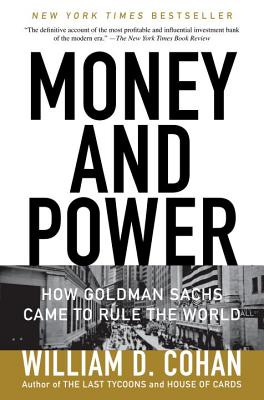I’m finally on Money and Power: How Goldman Sachs Came to Rule the World, the third William D. Cohan book I’ve read about the machinations of large financial firms. These are long, comprehensive, well-researched books. They also sometimes make me want to scream because they remind me of how small and powerless we all are, how our financial lives often hang in the balance, meaningless dots of information in a massive matrix.
I know I’m supposed to take different lessons from these books but as I read the bios of some of the legends of finance (Jon Corzine, Robert Rubin, and Hank Paulson are just some of the bold-faced names whose careers were amplified through their time at Goldman Sachs), I’m reminded of how entrenched the old boys network is. It’s not just the same schools; it’s before that, the language of sports and masculinity in general.
The firms Cohan covers may differ, but they all share the importance of winning at all costs, the need to conquer, the ability to cover for each other (whether it’s financial malfeasance or abuse of women), and the ability to risk. That last one, the ability to shoulder huge losses, to risk, to get into huge trouble and somehow wheel and deal your way out, seems most critical. However, it’s worth noting that not all companies make it out of these types of situations.
I’m at the very fringes of understanding the depths of money and trading. Sometimes, I question why I’m even bothering. This is hard; it makes my brain spin, it’s depressing, and the deck always seems stacked. But I also want to know the world of finance from as many angles as I can.
Books like this remind me that a firm like Goldman Sachs has two mandates: the one proudly shown on their website about using their expertise to serve clients and the internal one, to make the firm and each other much richer. I want to believe that those two tracks go in the same direction, but they don’t always, and from the outside, one has little way of knowing where and when they diverge.
Cohan starts his book with the Great Financial Crisis and a time when Goldman Sachs kept selling mortgage-related securities that it knew were risky and likely to fail and was, in fact, betting on them to do so. The company later paid an over $5 billion fine in relation to this; $1.8 billion was to go toward relief to aid consumers hurt by the company’s actions. This is a good example of why we still need financial watchdogs.
Conflicts of interest come up over and over again at Goldman Sachs. Cohan quotes Sam Zell, the great real estate investor who asked if Goldman Sachs was an agent or competitor. “I am happy with either one,” he said, “just not both.”
Zell could see the conflicts; most of the clients or others who were impacted all across the financial world couldn’t. While it’s somewhat natural for a large company to have many different arms and for some of those to be unaligned, what Cohan’s book shows is a consistent ability for the company to ignore or push aside conflicts in the service of making the company more money. As a shareholder (GS is in my portfolio), I want to see that. As a person, I am conflicted. I want the companies I own to succeed, but I know jobs are people, losses are people, and everything corporations do has reverberations for people they’ve never thought to care about.
Cohan’s book came out in 2012; maybe today’s Goldman is different. Somehow, I suspect it’s not. That makes me wonder a lot about where they see the next crisis coming (because there is always one coming) and where those future conflicts lie.






It doesn't seem like we learn our lessons. There's a meltdown of some sort. Congress enacts some kind of oversight. Things calm down. People (usually in large financial corporations) complain that everything is fine, we should get rid of that burdensome oversight so we can make more money... And we're off on another adventure in financial malfeasance. Given the current administration, we're due for another blowup in a few years.